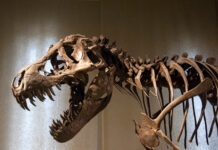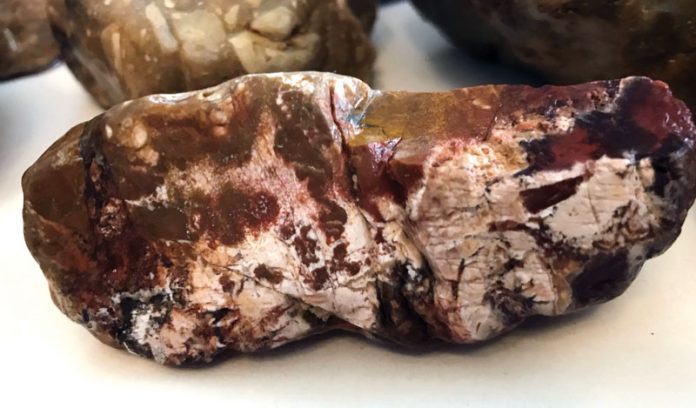
Where to find agates is a common question. Agates can be found in many places. A popular destination is Boley, Oklahoma, where the destination and agate name are the same.
Where to Find Agates – A Road Trip
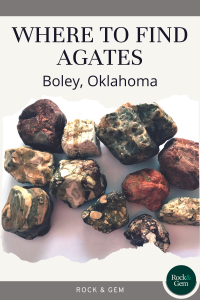
Like many lapidary artists, my wife and I love agates, so we flew the cabin to collect the Boley agate of Oklahoma. We took a run to a not too well-known site of an ancient river bed where striking, cutting and collecting material can be found. Our destination was Seminole County, Oklahoma.
The agate and conglomerates are named for an outcrop of the lapidary material found near Boley, Oklahoma in 1954 by E. R. Ries. No two are alike and the patterns and colors can be spectacular. They are relatively easy to work and they polish with a mirror finish. As experienced collectors know, the best agates are hard to find. Jasper is related to agate since both are silicates and some jaspers can be as spectacular as agates. It is a special site where good jasper, agate, puddingstone and brecciated silicates can be found together.
The Geology of Boley Agates
On this trip, I wanted to learn more about the geology and mineralogy of the finds so I contacted Neil Suneson who has worked for the Oklahoma Geological Survey since 1986 and is now retired. Neil graciously agreed to supply additional information on his research into the beautiful material found in Oklahoma. Dr. Suneson, Dr. Bill Lyons (East Central University in Ada) and David Goza (University of Oklahoma) have also cooperated on research into the properties of the conglomerate and the geology of the area.
Many of the Middle to Upper Pennsylvanian formations in east-central Oklahoma contain chert clasts. However, the Boley Conglomerate contains some varieties that have long been of interest to geologists and hobby collectors alike.
Where to Find Agates – The Boley Conglomerate
The Boley Conglomerate is the basal member of the Vamoosa Formation which extends from just north of Ada, Oklahoma to the Kansas line.
H.R. Ries first proposed that the conglomerate was deposited in an alluvial delta. Here, the Vamoosa contains more chert conglomerate than any other formation in the area with a total thickness of about 630 feet. The breccia is mostly angular; ranging in size from a fraction of an inch to three inches.
The formation consists of the following:
? 30 ft of dark shale
? 260 ft of chert conglomerates
? Red and brown sandstones
? Red shale
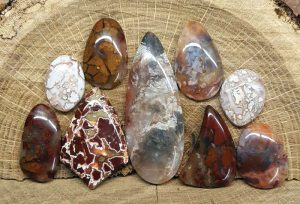
Boley conglomerates are widely spread in Seminole and Okfuskee Counties. The best-known outcrop of the Boley Conglomerate is the abandoned Donald Stover gravel pit located in southern Seminole County. Permission must be obtained before entering the property.
We had visited this site in the past, but also found superb specimens on the gravel roads in the area. The county and state road departments use the gravels and cobbles to build the county roads so the bar ditches provide easy access to finding specimens.
There is a wide family of cryptocrystalline quartz with microscopic characteristics. The terms jaspers, agates, flint, chert and carnelian are loosely used to describe the various varieties.
Banded Agate Formation
I had the opportunity to consult with Dr. Roger Pabian at the University of Nebraska on the formation of banded agate. He defines chalcedony as a general term to describe various cryptocrystalline quartz such as chert, jasper and agate. Agate is the banded form of chalcedony that is generally translucent.
Electron microscope studies by Dr. Landnesser have shown that the outer bands are composed of radically or spherically configured crystals and the inner bands are more fibrous chalcedony. It is the banded structures that make agates of interest to collectors and lapidary enthusiasts.
The various colors found in agates are produced by impurities in the silica matrix of which iron oxides and hydroxides are the most common. Pure agate is white, gray or blue-gray. Impurities, particularly the sulfa-salts and other minerals, are responsible for the banded structure. The minerals in contact with the silica gels generate a wavefront that creates the alternating composition of the bands.
Where to Find Agates
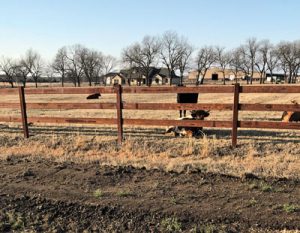
The impurities are the catalyst for the reaction front. turned up new specimens. Between Sasakwa and Highway 277 going west on Highway 56 from Sasakwa, there are several dirt roads turning north. There is no consensus on the origin of the chert or the processes that brought about the brecciation of the rock. Similarly, the source of the chert pebbles and cobbles is unknown. Further studies will be needed to find the answers to the perplexing question of origins. We began collecting on well-maintained gravel roads north of Sasakwa. The road we followed had just been graded which was fortunate for us because the grader had Boley agates can be found in the bar ditches and is quite available.
At any site the collector should high grade because there is plenty of leaverite, so be picky and choose the best material to work. In a couple of hours, we found a bucket of material that we knew would polish nicely. No shovels are needed to collect as the pebbles and cobbles lay loose in the ditches. A screwdriver is helpful to dislodge them. This site has very little traffic and can keep children fascinated by the finds.
Boley Agate Lapidary Possibilities
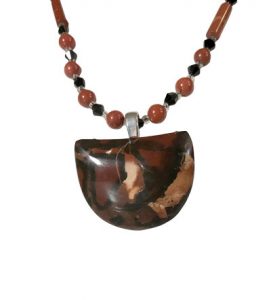
After returning home, I began working the material. Few fractures allowed for some fracture-free slabs. Because it is a quartz mineral, it takes a high mirror polish. I cut and polish and she puts the jewelry together. My shop has two sets of Highland Park eight-inch diamond grinding wheels (three to each set) ranging from a 100 grit wheel to a 50,000 grit polish wheel. I generally finish agate with tin oxide on a leather bull wheel.
Boley agates are great if you are a beginner or an old hand at lapidary work. Many agate collectors consider it a sin to cut up rare fine specimens but in the case of Boley agate, there is plenty for both collectors and lapidary folks.
Are the Boley Chart Breccia Clasts Truly Agate?Neil Suneson, William Lyon and David Goza differentiated the chert pebbles and cobbles found in the Boley Conglomerate as follows. Chert Breccia A. Subclasts are unconnected and appear to be unrelated to each other. They vary from rounded to angular, and they vary from pebble to grain-sized. In a sedimentary sense, the subclasts are moved far enough away from each other and separated by enough cement that cannot be reconnected. B. Stratified chert in which no delamination or brecciation has occurred. Small fossil fragments are present in some specimens; sponge spicules appear to be the most common. C. Slightly delaminated stratified breccias are a type of autoclastic breccia in which the original rock is sedimentary and the subclasts have delaminated largely along bedding planes. Stratified Chert A. Massive or unstratified chert. Clasts are typically pebble-size in the Boley Conglomerate that likely originated as a thickly stratified sedimentary rock. B. Stratified chert in which no delamination or brecciation has occurred. Small fossil fragments are present in some specimens; sponge spicules appear to be the most common. Banded Chert Banded agates are rare specimens with fracture fills or void space fillings in which the silica is banded like agate. Banded silica filling can constitute either a minor portion of the rock or most of it. The bands are not related to the original stratification. They represent repeated precipitation. |
This story about where to find agates previously appeared in Rock & Gem magazine. Click here to subscribe. Story by Bill Reynolds.




